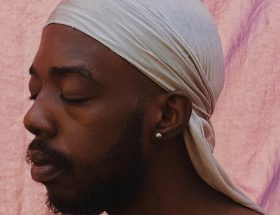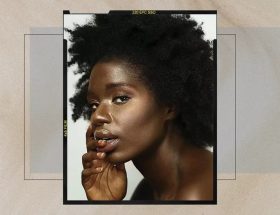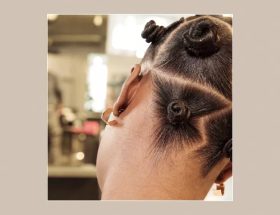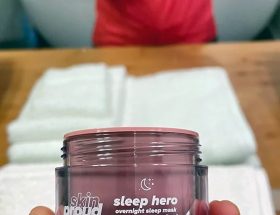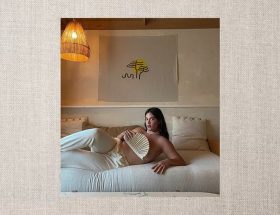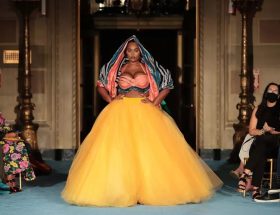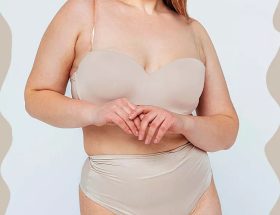It’s Time to Learn the History Behind The Silk Press
Welcome to Crowned, our new series all about the history of Black hair. Hosted by senior social media editor Star Donaldson, Crowned explores the history and traditions that have shaped the Black experience and the hairstyles born out of them. In our newest episode, we deep-dive into the silk press, a common straightening technique with rich cultural significance. Join us in learning more.
Natural hair is equally beautiful and versatile and, the glory of it is—the possibilities are truly endless. Whether you’re wearing your ‘fro in its natural state or rocking cornrows, many of the styles and trends that are popular today are rooted in Black history—including straight styles like the silk press.
By definition, the silk press is a temporary hair straightening technique that uses minimal product and flat iron to achieve bone-straight hair, Donaldson explains. Unlike chemical relaxers, which in its earliest days, utilized lye, a toxic metal hydroxide, to permanently straighten hair, the silk press is achieved with hot tools only. ” It presses curly hair into sleek straight strands,” says Donaldson. “This style is just a popular today as it was decades ago.”
According to research, Black people have been straightening their hair since the early 1900s mainly in part to discrimination. “Historically straightening our hair was an act of survival,” Donaldson explains. “After slavery was abolished, newly freed black Americans were virtually unprotected by the government, which led to widespread violence by terrorist groups.” Jim Crow laws also made it difficult for Black people to enjoy their full rights as citizens and secure employment. “Finding jobs and creating a life meant altering our hair texture in order to fit into the European beauty standards of the time,” Donaldson says. “Unlike cornrows or Bantu knots, hair straightening was born out of the need to survive in a racist society.”
“It’s important to know that hair straightening is a tool of adaption for Black people in a racist society.”
Before the silk press, there were other techniques for hair straightening, like pullers, which utilized two balls at the end of a handle, which gets pulled through the hair to loosen kinks and coils. In the 1920s, hot combs were popularized by Madam CJ Walker and, although the pioneer didn’t invent the tool, it was an essential part of her business. “When I’ve had my hair pressed, hairstylists have used a hot comb just before my edges to make my hair as straight as possible,” Donaldson shares. “So the tool is still pretty relevant today.”
After the modern natural hair movement in 2009, so many people gave up using chemical relaxers and wanted an option to wear straight hair temporarily—without the chemicals. This is where we see an even bigger resurgence in silk-pressed styles. “I wish I knew about this style when I was getting relaxers because it’s a lot safer and less damaging,” Donaldson explains.
You may have seen the silk press on some familiar faces, including Tia and Tamera Mowry back on Sister, Sister. The late singer, Aaliyah, was also major silk-press inspo, with her hair often styled side-parted bone-straight look. Former First Lady Michelle Obama also wore her hair silk pressed throughout her time in the White House. More recently, Obama’s silk pressed style at President Biden’s inauguration went viral, with people calling her look “The Michelle.”
Obama’s stylist Yene Demtew used the silk-press method on her client and finished her ends with curls lightly combed out for extra bounce. With the silk press, you have the option to wear your strands stick straight, with very little curl, or super voluminous, with curls and body throughout your hair. While celebrity stylists often utilize the technique on their clients, the silk press is also widely accessible and can be done at a salon. Some people have even mastered the process on their own and at home.
Former U.S. President Barack Obama and former first lady Michelle Obama arrive to the inauguration of U.S. President-elect Joe Biden on the West Front of the U.S. Capitol on January 20, 2021 in Washington, DC.
TASOS KATOPODIS/GETTY IMAGES
Although the silk press is a great method for temporary hair straightening, it’s important to note that exposing natural hair to high heat can be potentially damaging. It’s why silk-press pros insist on using a heat protectant product to keep the hair safe during the process. “One of the major steps is to use a heat protectant to minimize the heat damage on afro-textured hair,” Donaldson explains. “The style starts on twice shampooed hair that is then deep conditioned for 30 minutes in order stave off breakage and tangling.”
After your deep conditioner has done its work, hair is usually rinsed with cold water to close the cuticle. “Then hair Is blown out and straightened in small sections for that extra silky finish,” says Donaldson. Depending on your routine and lifestyle, a silk press can last you up to three weeks with maintenance, which should primarily include wrapping your hair at night with a satin scarf and minor touch-ups if necessary. Upon finishing your silk press (or if your strands feel dull or dry days later) you can smooth a lightweight oil serum or mist over your strands for extra shine. You can also use an edge control pomade along your hairline to keep that area smooth.


